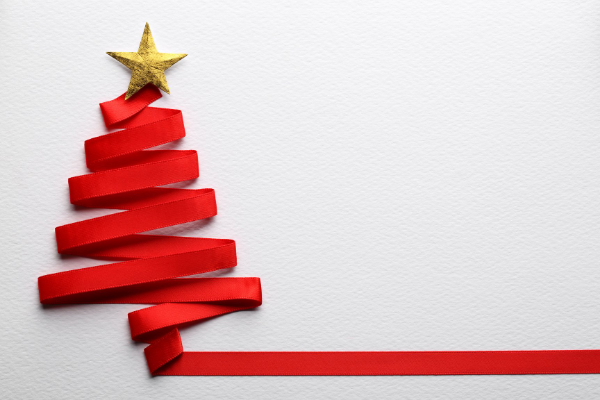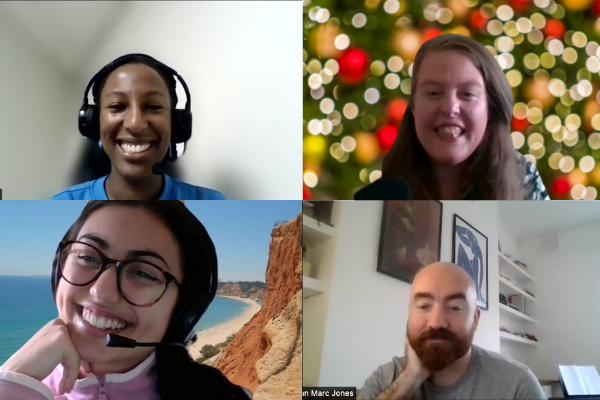Insights
INSIGHTS
All Topics
How to make Christmas cards and fundraise for charity
21 Nov 2024by Ioan Marc Jones
We explore the various ways that charities can raise funds and spirits by designing, creating, and selling fantastic Christmas cards
Charity Christmas cards are a staple of the season. The weather falls close to freezing and shops and websites are suddenly filled with colourful cards, with the best photography, animal and village designs, handcrafted messages, and plenty of humour. The popularity of such cards is huge. Take Cards for Good Causes, for example, who raised over £40 million in the last 10 years alone.
It’s been a long road to the present batch of cards. The first recorded ‘Christmas letter’ was sent in 1534, according to Why Christmas. The first letter than looked a bit like today’s Christmas cards followed almost a century later, in 1611. It was an ornamental manuscript, 84 x 60cm, folded into panels, with a picture of a rose in the centre. It contained a message to King James I and his son, with the addition of several poems and even a song, a tad more content than we’d expect today.
The first commercial cards were produced in London in 1843, according to The Smithsonian. Sir Henry Cole and John Horsley designed, printed, and sold about a thousand cards for one shilling each. Thus started a small phenomenon that continues to grow and grow, right up to the present day.
The popularity of charity Christmas cards is understandable. It can raise huge amounts and does not take too much time, especially if you do your research. So we want to help. Below is our complete guide to creating brilliant Christmas cards that will help spread joy and cheer at this time of year.
Skip to: Plan for the perfect Christmas card
Skip to: Think about type of Christmas card
Skip to: Designing your Christmas cards
Skip to: Make your charity Christmas cards
Skip to: Sell Christmas cards far and wide
Skip to: Learn from the process
Plan for the perfect Christmas card
‘Twas the month before Christmas and you still had no cards. That’s because you didn’t plan. Planning is essential for creating Christmas cards, as there are lots of steps you need to take. Below we run through where to start and, crucially, how to start.
When to start
The time spent planning will depend on the size of your charity, your ambitions and objectives, and resources and capacity at your disposal. Charities who distribute huge amounts of Christmas cards with various designs are likely to start early in the year, perhaps even starting planning in January.
For smaller charities, or charities that are outsourcing much of the process, you may only need a month in advance. Still, though, it’s better to start earlier than find yourself with problems later.
Remember that, if you start really late and you’re outsourcing, you may find that the designers, printers, distributors and other third parties are caught in the Christmas rush.
How to start creating Christmas cards
Start with brainstorming, floating around ideas. Then set down some targets. Then develop a comprehensive schedule and determine your budget. The key to the planning stage is not to designate time frames, resources, and responsibilities for all future stages.
Think about the amount of time each stage takes. Consider start and end dates for the following:
- Choosing the type of card
- Narrowing options for the design(s)
- Finalising the design(s)
- Starting the marketing process
- Producing the cards
- Making cards available to buy
- Selling and distributing cards
We will cover each of the above stages below, but your charity should establish dates for each. You may miss those dates, or you may find yourself ahead, but either way it’s important to have rough deadlines to guide your progress, so you can prioritise and distribute appropriate resources.
Share all essential planning information with all stakeholders. Ensure it is accessible and invite queries from the very beginning, which will mitigate any potential problems further down the line.
Think about type of Christmas card
Before we talk about the design, you might want to think about the type of card. Charities essentially have two broad options – physical cards and e-cards – and lots of types of each option. We will quickly look at the benefits and drawbacks of each option and offer some inspiration, too.
The benefits of e-cards
Fundraising platform DontSendMeACard.com says that e-cards have doubled through its site year-on-year for the past four years. Over 1400 charities have registered from the UK, USA, Australia, Ireland, and Canada. Through the fundraising dashboard charities can upload their own e-card designs, avoid the creation of a physical card, and distribute them in much the same way.
E-cards are increasingly popular, especially with the growth of climate awareness. It’s perhaps unsurprising that so many charities are climbing on the bandwagon, as there are heaps of benefits:
- Personalisation: E-cards are better suited to tailored messages, unique and individual designs, even the possibility of uploaded media within the card
- Cost-effective: Sending traditional cards can be costly and take up a lot of charity’s resources. E-cards are comparatively quick and easy, with the ability to complete the process within a week
- Environmentally friendly: Virtual cards are the best choice for the environment, as they typically use zero paper and rely on no transport or physical production
- Speed: E-cards take seconds to arrive in inboxes, so they are perfect last-minute gifts, and allow you to avoid delivery issues (and complaints) around the Christmas period
The value of the above benefits depends on the nature of your charity. Weigh up the costs and benefits of the e-card and make an informed decision, considering your resources, time, and capabilities.
The appeal of physical Christmas cards
Physical cards are the more popular option and have been used to raise funds for generations. There is a much broader appeal for physical cards, which has lasted despite the ease of digital.
Here are some of the main reasons people still opt for the physical:
- Personal touch: The physical shows that the sender has thought carefully and picked a card they think the receiver will enjoy. There is a longstanding process of picking the right card, weighing it in your hands, and giving it to someone special which cannot be emulated with e-cards
- Showcasing: You could print off your e-card, but that’s not the same. Physical cards are not just lovely sentiments, but they also serve as lovely decorations. People enjoy putting up Christmas cards around the house, on walls and windowsills and mantlepieces, to add a bit of Christmas spirit
- Aesthetics and feel: Nothing beats the feel of a physical card. To open and unravel a physical card is simply a better experience than the e-card, which can feel a little cold and quick
The appealing elements have led to the continued popularity, with physical Christmas cards still raising significantly more than the e-card. And, importantly, charities that create great physical Christmas cards stand to raise a lot of money at a vital period on the fundraising calendar.
The joys of eco-friendly Christmas cards
You can choose eco-friendly Christmas cards to mitigate the environmental impact of traditional physical cards. There are some brilliant companies that will create green Christmas cards.
Rosemood, for example, create eco-friendly cards that depend on recycled paper and only use renewable energy to create the cards, generated by wind turbines, solar panels, and hydroelectricity.
There are lots of innovative green designs that could be helpful, too. Take the seed cards, for example, which are made from recycled paper and seeds. That means that, after the Christmas period is over, rather than throwing the cards or storing them in the attack, you can plant them in your garden!
There are lots of companies and options for eco-friendly physical cards. The key is to do your research, find the best option for your charity, and then make your perfect sustainable Christmas cards.
Design your perfect Christmas card
So you’ve picked the type of card, now you need to think about design. Much of what we’ll talk about applies to physical cards, but the basic logic can be applied to e-cards, too.
Pick the design that matches your cause
Charities can pick designs that amplify their cause. You can make your card relevant to your mission, but perhaps avoid any imagery that might be off-putting. A good rule is to ensure that people would be willing to decorate their home with your card. If not, you may need to rethink the design.
A good example of a subtle card that amplifies the cause is Amnesty’s Dove design, which preaches peace but maintains beauty. Another great example is Friend of the Earth’s brilliant Christmas Card that places the world as a Christmas pudding, with a polar bear and holly to boot. The card amplifies the need to protect the earth with a playful message perfectly suited to the season.
You do not have to be too concerned with the cause. A beautiful Christmas card will sell, especially if the money is going to charity. There are plenty of brilliant examples of great designs that do not specifically highlight the cause, but still make a great card. Consider, for example, Action Aid’s comedic Nutcracker Christmas card, or UNICEF’s ‘Global Elves Workshop’ design.
Consider Christmas card trends
Now actually designing is tough. You may want to match the design with your cause, or not, but it’s important either way to think carefully about design. Below we look at some of the common trends and provide a little inspiration to kickstart your design journey:
Animals and the natural world
Animals and the natural world continue to be a firm favourite. Every year we see a shelves full of robins and hares, high trees and holly bushes, usually covered in snow or at least entertaining the temptation of snow. Other animals are breaking into that territory in recent years, too, with a recent surge of charity Christmas cards with pictures of highland cows and sheep.
Animals and the natural world are ever-popular and always make a great addition to any windowsill, wall, or mantlepiece. They are naturally a safe choice for environmental, heritage, and conservationist charities, who can preach the beauties of Mother Nature while raising money to protect her.
Local scenes
Local scene cards are also very popular. These range from villages to cities, all localised and intricate, imparting a sense of belonging upon the buyer and the receiver. St Giles Hospice has produced a range of brilliant local scenes, showing everyone how well it can be done.
One of the biggest benefits of volunteering or donating to a local cause is witnessing the impact in the community. Christmas cards can show off the local, building a greater sense of community and purpose with those who buy and receive. It can raise awareness of local charities, showing their intimate connection with a particular place and demonstrating allegiance to improving that place.
Religious designs
Classic religious designs are still popular, emphasising the religious message of Christmas and stressing the need to togetherness, a time for giving, and a time for forgiveness. The nativity scene remains popular, as do angels. The religious scenes are obviously more popular with Christian charities.
Community-led
Another option is letting donors and volunteers and members of the community contribute to the design. Think about perhaps having a competition at the local school, asking for submissions from local artists, or opting for a patchwork of local photography. Check out the School Christmas Card Project for a brilliant example of involving others in the design of the cards.
Involve users in the design and they will become more involved in buying, marketing, and selling your Christmas cards, not to mention raising awareness. And, with such levels of involvement, you may see more long-term donors supporting your cause.
Weird and wonderful
But it’s important that you are not constricted by the above. Trends have to be set by someone, so perhaps think outside the box, think about innovative and creative designs, and consider anything that you might be able to put together. Maybe you want to create a different shape, or maybe go retro with a pop-up card, or perhaps you want a signing card – the options are endless.
Christmas cards are an opportunity to showcase creativity. Remember, though, that any extra features may cost more in terms of production and could limit your fundraising potential. Remember also that weird and wonderful designs can be a risk, as they are more liable to fail than other designs.
Outsource Christmas card design
Charities can also reach out to businesses to take care of almost every element of creation. You can simply brief them, pay a set price, and they will send you a completed design. Or you could make it even simpler, picking from a templated design and adding your branding.
Plenty of companies offer such services, including:
There are some downsides to that tactic. The first is the loss of authenticity. Charities often want the card to represent them, to project something essential about the charity, to give people at the charity a greater sense of ownership. Outsourcing means giving up all of that.
Another downside is the cost. It is likely that outsourcing to any design company will lead to a more expensive production process. If the design increases sales, that cost may well feel justified. It’s often a question of balance, resources, and ability, which will be unique to every charity.
If you have opted to go with a design or a template version, you will likely be able to use the same website to print the cards. That saves a step – you can skip the next part, in that case – so may prove the best option for charities running a bit late.
Make the Christmas cards
The process of making cards varies substantially depending on the above steps. But there are broadly some simple steps you can take – all of which we will discuss below.
Making them yourselves
It’s a great option for micro charities. If you’re not producing thousands of cards, but rather hoping for local sales, you might consider doing the production yourselves. You might decide to have a specified design, grab some glue, coloured paper, and scissors, and start making them by hand.
A perhaps easier option is using a decent printer to get your imagery, folding cards, and putting the various bits together. That likely will save you the cost of outsourcing and, with a team of people, that shouldn’t take that long.
You can even pop hand-written messages inside the cards, adding an additional personal touch to every card that is bought from your charity.
Outsourcing the creation
Many companies offer charities the chance to produce bespoke range of cards on their website, or offer template designs that charities can pick from. If you want to make things as easy as possible, pick from one of their designs. The drawback is that the personal touch is limited, so we suggest doing the design yourselves. Besides, working on the design is the most fun part!
Then you’ll need to find someone who is willing to take your design and meet your specifications. You’ll need to ensure that company can print the necessary numbers, include all elements of the design, work within an agreed timeframe, and meet any other specific demands you might have.
Here are some of the most popular companies that print Christmas cards:
There are plenty of other options available online. Do your research, compare the competition, and pick the best company for your charity. Then all you need to do is wait for the cards to arrive!
Sell Christmas cards far and wide
Now you need to sell the cards. There are various ways in which you can sell your charity Christmas cards, but we will cover the main ones below, with helpful tips and advice.
In-person sales
In-person sales depends on your reach, capacity, and objectives. You want to get them into shops that are based near you. Local charities should start locally and, if you can, work outwards, as that makes it easier to keep the stock levels up as necessary.
Approach pubs, garden centres, local shops, gift shops, florists, grocers, antique shops, and any other outlet that might want to sell cards. If you have a charity shop, whether big or small, it goes without saying that you should sell the cards in your shop.
Online sales
The best way to ensure strong online sales is through a website. You will need to create an eCommerce shop on your website, if you don’t have one already. By opening an eCommerce shop on your website, donating suddenly feels much more like a normal online transaction. Website plugins can help with everything from accepting payments, to creating an easy check-out process.
Once you have a dedicated page, you can start promoting on social media and with email marketing, pushing people to the page. Any newsletters or internal comms can also link through the dedicated page, ensuring as much visibility as possible. Remember that marketing is essential if you’re only selling online, as you need to create as much visibility of the product as necessary.
For more, check out our guide: A complete guide to digital marketing
If you do not have the means or capacity to set up a website, consider partnering with an ecommerce platform like Shopify or GoDaddy. These platforms can offer more functionality to your merchandise fundraising, including tracking and campaign analytics, and easy Facebook and social media integration.
For information on other merch, check out our article: How to create charity merchandise
Learn from the process of creating Christmas cards
Christmas is over. You’ve sold loads of cards, eaten far too much Christmas dinner, maybe had an eggnog or two on Boxing Day, and Spring is approaching. Now you need to think about what you did well, what you did wrong, and think of ways of improving the process in the future.
What snags did you face on the journey? Did you stick to schedule and budget? Were there any project management problems? How did third parties perform? Did suppliers meet expectations?
Think about the entire process and brainstorm on future improvements. Christmas comes once a year and provides a great opportunity for fundraising. So learn from the process, build on your successes, and make sure that every year your Christmas cards are more joyful than the last!
Ioan Marc Jones
More on this topic
Related Content
Recommended Products
Related Videos
Our Events
Charity Digital Academy
Our courses aim, in just three hours, to enhance soft skills and hard skills, boost your knowledge of finance and artificial intelligence, and supercharge your digital capabilities. Check out some of the incredible options by clicking here.



























